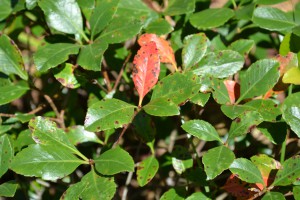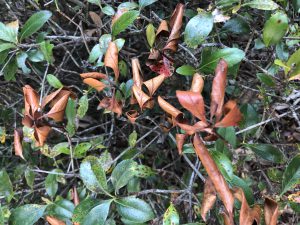
Reddish, round spots are the first sign of Entomosporium Leaf Spot on Indian Hawthorn. Photo credit: Beth Bolles, UF IFAS Extension
Indian hawthorn (Rhaphiolepis spp.) is one of those great evergreen shrubs with such a reputation for hardiness that most folks tend to plant it and not worry about it. Indian hawthorn is not a Florida native, but is adapted to our weather conditions and is widely used in home landscapes throughout the Southeast.
However, it is important that homeowners and landscape managers pay attention to them, particularly during the warm, often wet weather growing season. During such conditions, the plant is vulnerable to Indian hawthorn leaf spot, caused by a fungus called Entomosporium mespili. Several years back, this fungus spread through the once-popular red-tip plant (Photinia fraser), to the extent that this species is now rarely used.

An Indian hawthorn plant heavily affected with leaf spot fungus can be covered with round circles on the green leaves, eventually leading to plant death. Photo credit: Carrie Stevenson, UF IFAS Extension
Symptoms of leaf spot fungi include small, circular red spots on young leaves, which then expand into larger patches. On older leaves, the spots are gray in the middle with red/maroon borders. Eventually, leaves can drop and entire plants may defoliate and die. The disease typically spreads through rainwater or overhead irrigation.
To manage the disease, it is best to create space between a sick plant and a healthy one to allow better air circulation. This will allow leaves to dry off after rainfall events and prevent expansion of spores. Be sure not to overwater, prune, or fertilize shrubs that show signs of the disease, as this encourages growth—the fungus thrives particularly well on young, vigorously growing leaves.
For leaf spot problems that become difficult to manage with just cultural practices, fungicides containing chlorothalonil, myclobutanil, or propiconazole may be used. Always follow label instructions when using chemical management and apply in the spring or fall. In addition, dead or dying plants should be removed and replaced with cultivars showing resistance to Entomosporium leaf spot, including Eleanor Tabor, Indian Princess, Gulf Green, Betsy, Blueberry Muffin, Georgia Petite, Olivia, and Snow White.
- The Praying Mantis - June 20, 2025
- Bluebirds in Florida - May 8, 2025
- The Brahminy Blind Snake - April 10, 2025
